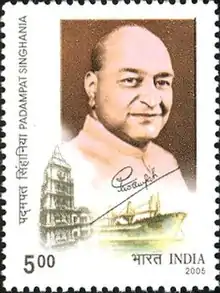Padampat Singhania
Sir Lala Padampat Singhania (3 February 1905[1] – 18 December 1979)[2][3] was an Indian industrialist and member of the Indian Constituent Assembly.

He was born in Kanpur into a prominent Marwari family,[4] the oldest grandson of Lala Juggilal and son of Lala Kamlapat Singhania. His brothers were Kailashpat (who owned Raymonds) and Lakshmipat Singhania.[5]
He was chairman of the JK Mills, part of the J. K. Organisation. He was knighted in the 1943 New Year Honours list,[6] and invested with his knighthood by the Viceroy of India, the Marquess of Linlithgow, at Viceroy's House (now Rashtrapati Bhavan) in New Delhi on 23 February.[7] After independence in 1947, he became a member of the Indian Constituent Assembly and was one of the signatories of the Indian constitution, but chose not to enter politics.[8]
References
- Bhushan, Ravi (1975). Famous India, Nation's Who's who. Famous India Publications. p. 172. Retrieved 1 May 2019.
Singhania, Sir Padampat ; Industrialist ; b February 3, 1905 Kanpur
- The Times of India Directory and Year Book Including Who's who. 1982. p. 237. Retrieved 1 May 2019.
- Our Founders. jkcotton.com
- Markovits, Claude (2002). Indian Business and Nationalist Politics 1931-39: The Indigenous Capitalist Class and the Rise of the Congress Party. Cambridge University Press. p. 212. ISBN 9780521016827. Retrieved 1 May 2019.
- Ashish K. Mishra, P.R. Sanjai (29 July 2015) Singhania vs Singhania: what went wrong? LiveMint.
- The London Gazette, 1 January 1943
- London Gazette, 23 March 1943
- "What links Tata to Singhania? Singur!" Indian Express. 17 June 2011.